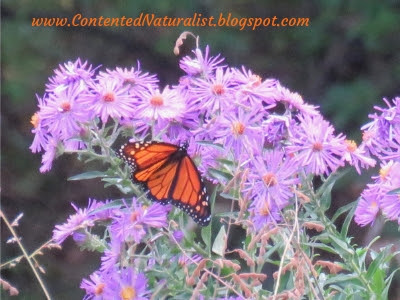 |
| This Carpenter Bee picked up both pollen and nectar from the Swamp Milkweed in my yard |
The National Wildlife Federation's plant finder has you enter your zip code to see a list of native plants for your area, ranked by how many caterpillar species (butterflies as well as moths) each plant supports. Since most birds rely on caterpillars to feed their babies, this site can also help you support birds as well as butterflies and moths. Yum!
The Audubon Society also offers a native plant finder that is based on your zip code. You’ll get a list of plants for your area that are easy to grow and should be available at native plant nurseries. Beside each plant’s description you’ll also see thumbnails of the birds it attracts. Audubon also lists nearby nurseries (and their web sites). identifying types of birds that may be attracted to each suggested plant, and basic appearance and culture needs for each plant. There’s even a “Buy Now” button for each plant, with options of either “buy local” (nearby Audubon chapters that offer plant services, nearby native plant nurseries) or “buy on Amazon.” Before you click “buy on Amazon,” you can follow a link to read tips about buying plants online.
 |
| Monarchs love late-booming flowers like these asters. |
The Lady Bird Johnson Wildflower Center in Texas hosts helpful resources about native plants on its web site. You can find information about commercially available plants that are native to your state, explore plants that are especially good for bees or for hummingbirds, and even find a list of nurseries that carry native plants. You’re supposed to be able to narrow that supplier list by state or zip code, but that tool seemed broken as I write this. A workaround is just to click “show all suppliers,” and scan the list to find nurseries or seed sources that are near you.
The Mt. Cuba Center, in Delaware, is a native plants botanic garden. While the garden is closed during the winter, the web site has lots of information about native plants for the Mid-Atlantic area. It won’t help you much if you live in another part of the country, but the site does give you much more detail about the specific plants and their culture & habitat needs than National Wildlife Federation’s tool. You can also refine the list by plant type, amount of sun needed, foliage type, and/or flower color, to find just the right plant for your garden.
Lastly, the Habitat Network and Project Yardmap are great resources that unfortunately have just lost funding. All of the articles are still available, and will eventually be moved over to Cornell Lab of Ornithology’s All About Birds web site. Until January 31, 2019, you can still find resources at http://content.yardmap.org/learn/, such as pictures of birds in your area sorted by what kind of food they like. You can click individual birds to find out their specific plant preferences and other habitat needs.
 |
| Goldfinches love seed-bearing flowers like this sunflower. Coneflowers are also popular. |
Of course, even better than online plant finders like these would be personal observation and experience. If you’re willing to wait a year or two before deciding, then you could try to find the plants on your list in the wild. That way you can see how it looks through all seasons, and observe how many birds, butterflies, or bees visit.
But you probably don’t want to wait that long. (I know I usually don’t!) So your next best choice would be to ask for advice and impressions from folks who have long experience with the plant. If you don’t have neighbors like this, you could try social media—there are tons of gardeners online who are happy to share our knowledge. You could also ask me in the comments below!
Whatever you choose to do, and whatever plants you select, have fun! Even “failed” gardening still gets us outside and brings us more in touch with nature. So in that sense, there’s really no 100% wrong plant selection. Just keep planting more, you’ll eventually find the ones that work best.
No comments:
Post a Comment